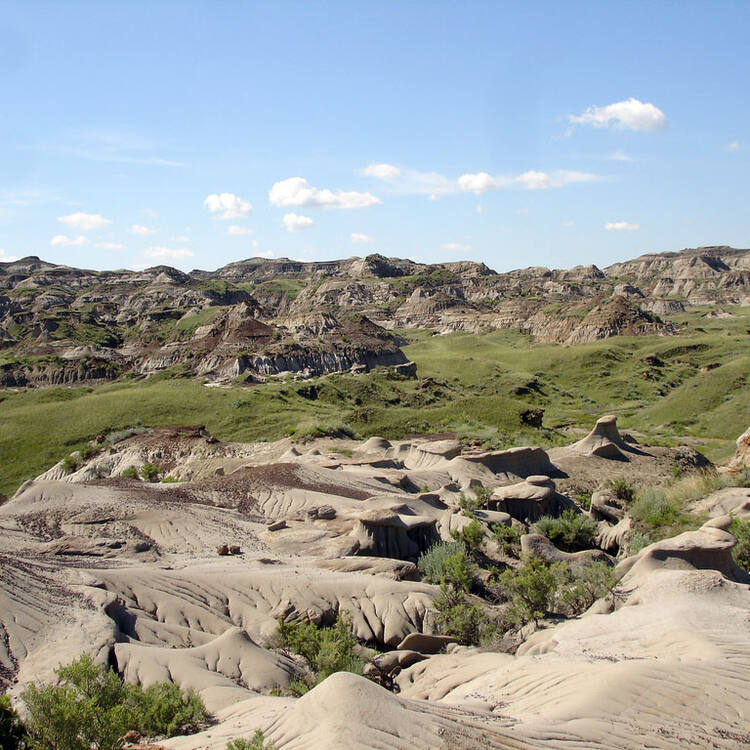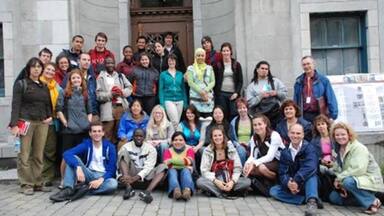Dinosaur Provincial Park
Dinosaur Provincial Park
In addition to its particularly beautiful scenery, Dinosaur Provincial Park – located at the heart of the province of Alberta's badlands – contains some of the most important fossil discoveries ever made from the 'Age of Reptiles', in particular about 35 species of dinosaur, dating back some 75 million years.
Description is available under license CC-BY-SA IGO 3.0
Parc provincial Dinosaur
Outre ses paysages d'une grande beauté, le parc, situé au cœur des bad-lands de la province de l'Alberta, contient les vestiges les plus importants qu'on ait jamais trouvés de l'« âge des reptiles ». Il s'agit en particulier d'environ 35 espèces de dinosaures remontant à quelque 75 millions d'années.
Description is available under license CC-BY-SA IGO 3.0
الحديقة المحلية للدناصير
تقع هذه الحديقة التي تتميّز بمناظرها الطبيعية الخلاّبة في عمق الأراضي الجرداء في مقاطعة ألبرتا وهي تحوي أهم الآثار المكتشفة من "عصر الزواحف"، وبوجه خاص آثار لحوالى 35 جنساً من الدناصير التي ترقى إلى 75 مليون سنة تقريباً.
source: UNESCO/CPE
Description is available under license CC-BY-SA IGO 3.0
艾伯塔省恐龙公园
艾伯塔省恐龙公园位于艾伯塔省荒地的中心,公园内除了特别秀丽的风景之外,还有许多最为重要的“爬行动物时代”(Age of Reptiles)的化石,特别是可以追溯到7500万年前的35种恐龙化石。
source: UNESCO/CPE
Description is available under license CC-BY-SA IGO 3.0
Провинциальный парк Дайносор
Парк Дайносор, располагающийся посреди каменистых степей в провинции Альберта, отличается не только внешней экзотичностью, но и содержит одну из ценнейших коллекций ископаемых находок, относящихся к «Эре рептилий». В частности, это останки динозавров, принадлежащих примерно к 35 разновидностям, жившим 75 млн. лет назад.
source: UNESCO/CPE
Description is available under license CC-BY-SA IGO 3.0
Parque Provincial de los Dinosaurios
Situado en la zona desértica de la provincia de Alberta, este parque de bellísimos paisajes contiene los más importantes vestigios de la "Era de los Reptiles" encontrados hasta la fecha. Se trata concretamente de 35 especies de dinosaurios que vivieron hace unos 75 millones de años.
source: UNESCO/CPE
Description is available under license CC-BY-SA IGO 3.0
恐竜州立自然公園
アルバータ州南東のレッドディア川流域にある自然公園。荒れた山地の絶壁状の露頭から、1910年以降の発掘で、この公園の貴重な特色である白亜紀後期のアルバータサウルスなど7科60種類の恐竜化石が多数発見されました。またイヌワシやハヤブサなど絶滅の危機に瀕している多数の生物も生息しています。source: NFUAJ
Provinciaal dinosauruspark
Het Provinciaal dinosauruspark ligt in de ‘Badlands’ in het hart van de provincie Alberta. Dit deel van Canada was 15.000 jaar geleden vlak en bedekt met een ijskap van ongeveer 600 meter dik. Het natuurgebied is prachtig en bevat daarnaast enkele van de belangrijkste fossiele vondsten van het ‘Reptielen Tijdperk’ ooit gedaan, in het bijzonder 35 soorten dinosaurussen die dateren van ongeveer 75 miljoen jaar geleden. Grote rivieren die hier 75 miljoen jaar geleden stroomden, lieten zand en modder achter. Deze maken nu deel uit van de valleimuren en heuvels in het huidige Provinciaal dinosauruspark.
Source: unesco.nl
Outstanding Universal Value
Brief synthesisDinosaur Provincial Park contains some of the most important fossil specimens discovered from the “Age of Dinosaurs” period of Earth’s history. The property is unmatched in terms of the number and variety of high quality specimens which, to date, represent more than 44 species, 34 genera and 10 families of dinosaurs, dating back 75-77 million years. The park contains exceptional riparian habitat features as well as badlands of outstanding aesthetic value.
Criterion (vii): Dinosaur Provincial Park is an outstanding example of major geological processes and fluvial erosion patterns in semi-arid steppes. These badlands stretch along 26 kilometers of high quality and virtually undisturbed riparian habitat, presenting a landscape of stark but exceptional natural beauty.
Criterion (viii): The property is outstanding in the number and variety of high quality specimens representing every known group of Cretaceous dinosaurs. The diversity affords excellent opportunities for paleontology that is both comparative and chronological. Over 350 articulated specimens from the Oldman and Dinosaur Park formations including more than 150 complete skeletons now reside in more than 30 major museums. In addition to the significant number of high quality specimens, the property contains a complete assemblage of non-dinosaurian fossil material offering an unparalleled opportunity for the study of the Late Cretaceous paleo-ecosystem.
Integrity
At 7,825 ha in size, the property encompasses a significant portion of the badlands and riparian habitat elements found in the region. Geological processes that created and continue to be necessary to maintain the badlands landscape occur with virtually no impairment or human interference. The high natural aesthetic qualities of the badlands and riparian areas are largely intact. In many parts of the property few, if any signs of development outside of the World Heritage site’s boundaries are visible.
The known presence of Late Cretaceous fossil material is closely associated with locations where the fossil-bearing formations are exposed through erosional processes. The large majority of these exposures in the region occur within the boundaries of the property. Both the fossil material and the highly valuable associated contextual information are wholly intact. Public access to the most sensitive areas of the site is strictly controlled. Research, collection and removal of fossil material are tightly regulated. Future facility development will only be permitted within the existing facility zone.
Protection of paleontological resources, badlands landforms, and riparian habitat was enhanced in 1992 through an extension of the property of 2033 ha.
Protection and management requirements
The protection and management of the property is enabled through a number of different statutes of the Province of Alberta, notably the Provincial Parks Act and the Historic Resources Act. Strong collaboration with stakeholders and local landowners in relation to management issues is occurring on an ongoing basis. The park’s 2012 Park Management Plan provides guidance in decision-making relating to the day-to-day operation of the park and managing identified issues. The Management Plan establishes a zoning system that restricts unguided public access to the most sensitive areas of the site.
All aspects of the management and operation of the site are overseen by a park manager located on-site. Proactive enforcement of statutes dealing with the protection of fossil resources is carried out by a number of trained staff. Land use activities are actively managed and impacts from visitor activities, facility operations and livestock grazing are being controlled and monitored.
The property is underlain by significant sub-surface petroleum resources. No surface access is granted for hydrocarbon extraction within the property; however, through the use of directional drilling techniques industry is able to access the subsurface resources underlying the property from outside of its boundaries. Hydrocarbon extraction activities that are occurring outside the property are actively managed and closely monitored to ensure that both the visual and environmental impacts are minimized.
Special attention will be given over the long term to monitoring and taking appropriate actions related to a number of factors in and near the property. Specifically, these include the potential development of infrastructure and facilities, livestock grazing, oil and gas extraction, impacts of tourism, visitors and recreation, potential impacts of climate change, as well as illegal removal of paleontological resources from the property.

